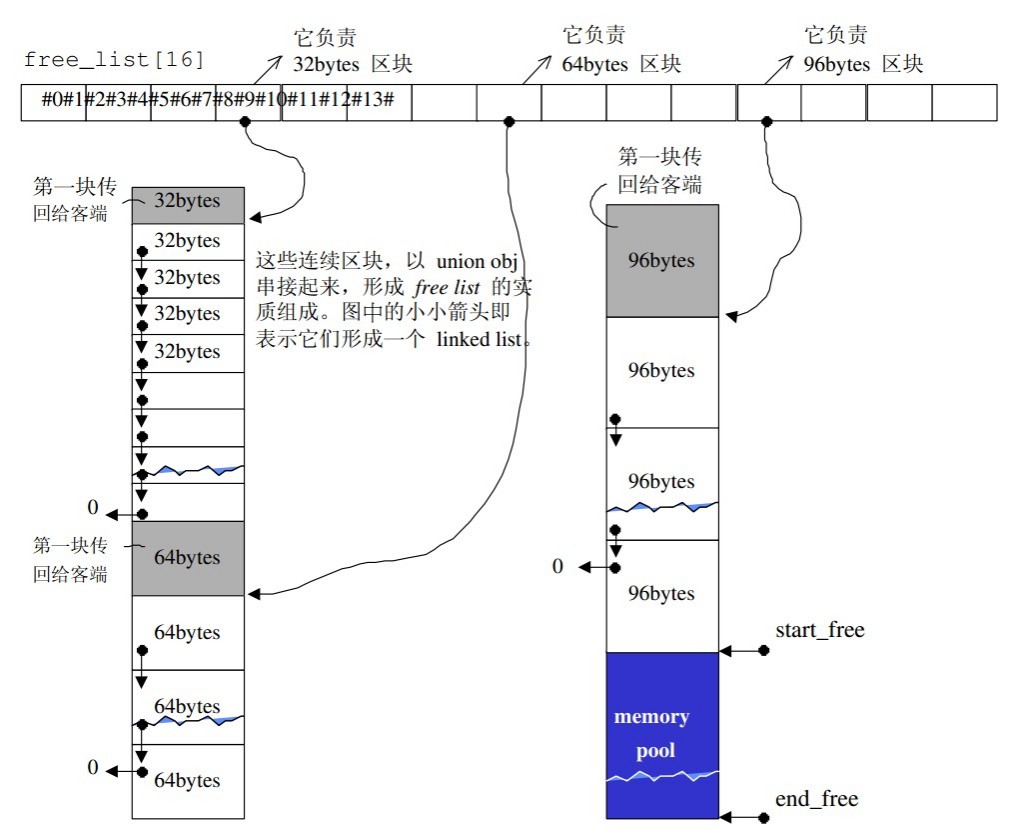仿照实现SGI-STL空间配置器 --15 April 2015
STL里面的Allocator是用来管理空间分配的,这里的空间基本上指的就是内存,管理内存是影响到很多STL的容器性能的主要因素之一,所以对Allocator的了解需要非常深入而不是仅仅知道如何调用.笔者前段时间大致的看了侯捷老师的那本<<STL源码剖析>>,对SGI版本的STL算是有点简略的认识,可是这种走马观花的认识也只能帮助我理解其大致机理,当遇到真正让你实现一个简单的Allocator时候就会显得束手无策,所以有必要通过编码,简单临摹一下SGI的Allocator.
简单粗暴Naive方式实现Allocator
我们可以编写一个最简单的符合STL规范的Naive版本的Allocator,它起码需要allocate/deallocate函数用来申请/释放空间,construct/destroy函数用来在内存空间上构造和析构对象, 还有rebind成员模板以及一些类型别名等.
这个Allocator只是简单的申请/释放空间,没有任何特别之处.
template<typename T>
class allocator{
public:
//常用类型别名,符合STL规范
typedef T value_type;
typedef T* pointer;
typedef const T* const_pointer;
typedef T& reference;
typedef const T& const_reference;
typedef unsigned int size_type;
typedef int difference_type;
template<typename U>
struct rebind{
typedef allocator<U> other;
};
allocator() = default;
allocator(const allocator &rhs) = default;
~allocator() = default;
//常用函数, 符合STL规范
pointer allocate(size_type n, const void* hint= 0);
void deallocate(pointer p, size_type n);
size_type max_size() const;
void construct(pointer p, const T& x);
void destroy(pointer p);
pointer address(const_reference x) const;
};
template<typename T>
typename allocator<T>::pointer allocator<T>::allocate(size_type n, const void* hint){
return _allocate(n, (pointer)NULL);
}
template<typename T>
void allocator<T>::deallocate(pointer p, size_type n){
_deallocate(p);
}
template<typename T>
typename allocator<T>::size_type allocator<T>::max_size() const{
return UINT_MAX/sizeof(T);
}
template<typename T>
void allocator<T>::construct(pointer ptr, const T& value){
_construct(ptr, value);
}
template<typename T>
void allocator<T>::destroy(pointer ptr){
_destroy(ptr);
}
template<typename T>
typename allocator<T>::pointer allocator<T>::address(const_reference x) const{
return (pointer)&x;
}上面用到的allocate, deallocate, construct和destroy函数定义如下:
template<typename T>
inline T* _allocate(ptrdiff_t size, T*){
T* tmp = (T*)(::operator new((size_t)(size*sizeof(T))));
// ::operator new 最底层的内存分配,类似malloc
if(tmp == 0){
qError("out of memory, allocate failed.");
}
qDebug("_allocate");
return tmp;
}
template<typename T>
inline void _deallocate(T* p){
::operator delete(p);
qDebug("_deallocate");
}
template<typename T1, typename T2>
inline void _construct(T1* p, const T2& value){
new(p) T1(value); //new 指定内存位置的用法
qDebug("_construct");
}
template<typename T>
inline void _destroy(T* p){
p->~T();
qDebug("_destroy");
}SGI版本的两级Allocator实现
SGI的Allocator有两个版本,一个是类似上面提到的Naive版本,它是为了兼容通用的STL标准,但是这个版本SGI从来不用,而是使用两级的Allocator,这个Allocator与STL标准不兼容,只能被SGI-STL的容器使用,这里就简单介绍一下SGI两级Allocator的设计思路.
两级Allocator
SGI的Allocator分为一级和二级Allocator,其中一级Allocator负责管理大于128字节的内存请求,而二级Allocator负责小于等于128字节的内存请求.
一级Allocator
这里我实现的一级Allocator名字叫做superior_allocator,它的成员函数解释如下:
- allocate函数负责分配指定大小内存
- deallocate函数负责释放指定指针的内存
- reallocate函数负责再次申请扩充内存
- set_allocate_failed_handler函数用来接受使用者定义的内存不足处理函数,在遇到内存不足时候可以调用此函数期望释放部分内存
- oom_allocate函数用来处理allocate函数分配内存时候由于内存不足而失败这种情况
- oom_reallocate函数用来处理reallocate函数分配内存时候由于内存不足而失败这种情况
template<int inst>
class superior_allocator{
private:
//allocate when out of memory
static void* oom_allocate(size_t n);
static void* oom_reallocate(void* ptr, size_t old_sz, size_t new_sz);
// use defined handler when out of memory
static void (*allocate_failed_handler)();
public:
static void* allocate(size_t n);
static void deallocate(void* ptr, size_t);
static void* reallocate(void *ptr, size_t old_sz, size_t new_sz);
static void set_allocate_failed_handler(void (*f)());
};其中具体函数实现如下:
//初始化内存不足处理函数指针
template<int inst>
void (* superior_allocator<inst>::allocate_failed_handler)() = 0;
template<int inst>
void* superior_allocator<inst>::allocate(size_t n){
void* result = malloc(n);
if(result == NULL){
return oom_allocate(n);
}
return result;
}
template<int inst>
void* superior_allocator<inst>::oom_allocate(size_t n){
if(allocate_failed_handler == 0)
throw hu::THROW_BAD_ALLOC;
void* result = 0;
//一直在不断的循环尝试
while(result == 0){
//调用处理例程,试图释放一些内存
allocate_failed_handler();
result = malloc(n);
}
return result;
}
template<int inst>
void superior_allocator<inst>::deallocate(void* ptr, size_t){
free(ptr);
}
template<int inst>
void* superior_allocator<inst>::reallocate(void *ptr,
size_t old_sz, size_t new_sz){
void* result = realloc(ptr, new_sz);
if(result == 0){
return oom_reallocate(ptr, old_sz, new_sz);
}
return result;
}
template<int inst>
void* superior_allocator<inst>::oom_reallocate(void* ptr,
size_t old_sz, size_t new_sz){
if(allocate_failed_handler == 0)
throw THROW_BAD_ALLOC;
void *result = 0;
while(result == 0){
allocate_failed_handler();
result = realloc(ptr, new_sz);
}
return result;
}从实现代码可以看出来,一级Allocator其实也很简单,和上面提到的Naive方式几乎差不多,就是malloc/free/realloc, 遇到malloc/realloc失败的话不断的调用用户处理函数以释放部分内存.之所以这么简单,是因为一级Allocator一般只处理较大内存块的分配管理,所以可以不用像二级Allocator那么斤斤计较,管理严密.
二级Allocator
这里我编写的二级Allocator名字叫做junior_allocator,它是完全按照SGI的设计思路实现的,负责较小内存块的管理.
free_list指针数组
要了解SGI二级Allocator的原理就必须先了解free_list指针数组,free_list指针数组的原型如下:
static obj* free_list[FREE_COUNT];这里势必要介绍一下obj的原型:
union obj{
obj* next;
char data[];
};这个obj的设计非常巧妙,是一个union,这样设计有以下几点好处:
- 一个obj的地址也就是其data指针值,这样方便通过obj的data值读出其内存地址.
例如, 我们有obj o那么o.data其实就是&o, 也就执行o的具体位置
- 一个obj的next字段用来存储指向下个节点的位置,这样能形成类似链表一样的结构.
- 通过union结合就可以避免单独开辟空间存储指针的空间浪费
结合obj的原型我们再来看free_list指针数组,我们这里free_list指针数组的大小FREE_COUNT = 128 / 8 = 16, 于是有16个obj指针,这16个obj指针分别指向第一个空闲的8字节,16字节,...,128字节内存块的位置
我们可以初始化时候为每个free_list[i]申请连续20个相应块空间,作为备用,初始化之后的内存使用情形如下图:

上图的free_lst指针数组中的指针指向其对应第一个空闲块,然后后续空闲块通过神奇的obj*连接而成,这里就可以体现到obj设计的精妙了,它一点也不浪费空间,而且还是非常精简的.
另外,对于上图需要解释的就是start_free到end_free这块空间就是junior_allocator分配的还未被使用的空闲内存池.
allocate和deallocate的实现
reallocate基本上就是调用allocate和deallocate,这里就不作表述.
allocate过程
我们试图从junior_allocator申请大小为n字节的内存,如果n > 128,那么交给superior_allocator完成,否则先根据n的大小算出相应内存块大小,比如n = 7那么内存块大小就是8.接着从free_list中找出相应的内存块第一个空闲内存地址free_list[i],如果此时有空闲块,那么返回此块地址,并且free_list[i] = free_list[i]->next即指向下一个空闲块;如果不存在空闲块,那么试图从空闲的内存池中申请一块连续的内存,然后切分成free_list[i]对应内存块大小的小块,然后更新free_list[i].
这里我们可以看到,每次某个内存块不够用时候就从内存池取出新的加入,总有内存池用完的时候,当内存池用完了该怎么办呢?这里有两个解决办法:
- 通过malloc再申请一快大内存池
- 如果系统所有内存都不够了,那只能从其他free_list中扣除一些内存过来了,因为每个free_list[i]都分配了一定数量的内存块,而有些free_list[i]可能用的很少,所以尚存空闲块,那就把它们的抢占过来.
deallocate
deallocate实现非常简单,如果释放的空间大于128字节,那么就交给一级allocator处理;如果不是,则把内存块加到对应free_list[i]中,通常做法就是直接插入大free_list[i]对应链表的表头.
代码实现
junior_allocator类定义
const size_t LARGE_SIZE = 128; //超过128B就由superior_allocator分配
const size_t SLICE_SIZE = 8; //递增片大小
const size_t FREE_COUNT = LARGE_SIZE/SLICE_SIZE; //free list个数,8,16,...128
const size_t CHUNK_NUM = 20; //默认每个尺寸的chunk一次分配的个数
template<int inst>
class junior_allocator{
private:
union obj{
obj* next;
char data[];
};
//free_list指针数组
static obj* free_list[FREE_COUNT];
static char* start; //当前可分配内存池的开始位置
static char* finish; //内存池结束位置
static size_t heap_size; //当前堆大小
//计算size应该分配的内存块的编号
//8字节内存块对应0号,16字节内存块对应1号...
static size_t march_node(size_t size);
//计算第node_id号内存块的大小
static size_t node_size(size_t node_id);
//从内存池申请n个node_id号内存块大小的连续内存
static char* chunk_alloc(size_t node_id, size_t& n);
//通过从内存池取新的内存将free_list[node_id]重新填充
static void* refill(size_t node_id);
public:
static void* allocate(size_t n);
static void* reallocte(void* ptr, size_t old_zs, size_t new_sz);
static void deallocate(void* ptr, size_t);
};superior_allocator成员函数具体实现
template<int inst>
char* junior_allocator<inst>::start = 0;
template<int inst>
char* junior_allocator<inst>::finish = 0;
template<int inst>
size_t junior_allocator<inst>::heap_size = 0;
template<int inst>
typename junior_allocator<inst>::obj* junior_allocator<inst>::free_list[FREE_COUNT]
= {0, 0, 0, 0, 0, 0, 0, 0, 0, 0, 0, 0, 0, 0, 0, 0};
template<int inst>
size_t junior_allocator<inst>::march_node(size_t size){
return (size-1) / SLICE_SIZE;
}
template<int inst>
size_t junior_allocator<inst>::node_size(size_t node_id){
return (node_id + 1) * SLICE_SIZE;
}
template<int inst>
char* junior_allocator<inst>::chunk_alloc(size_t node_id, size_t &n){
size_t requre = n*node_size(node_id);
size_t size_left = finish - start;
char* result;
if(size_left < requre){//剩余空间不够
if(node_size(node_id) < size_left){
//还够分配一个node
n = 1;
result = start;
start = start + node_size(node_id);
return result;
}else{//一个都不够分配了
if(size_left > 0){
//把剩余空间分配给相应free_list
/*
* 由于每次分配堆大小都是8的整数倍
* 所以剩余的肯定属于8,16,24,...必然
* 有一个与它完全适配,不会发生内存碎片
*/
size_t node_march = march_node(size_left);
assert(size_left == node_size(node_march));
obj* cur = (obj*)start;
cur->next = free_list[node_march];
free_list[node_march] = cur;
start = finish;
}
size_t add_size = requre + (heap_size >> 4);
start = (char*)(::operator new(add_size));
if(start == 0){
//分配内存失败
//应该从合适的free_list中回收一定的内存
for(size_t i = node_id + 1; i < FREE_COUNT; i++){
if(free_list[i] != 0){
result = (char*)(free_list[i]);
free_list[i]= free_list[i]->next;
start = result;
finish = start + node_size(i);
return chunk_alloc(node_id, n);//再次尝试分配
}
}
//实在不行调用一级空间适配器以调用用户定义的处理历程
start = (char*)(superior_allocator<inst>::allocate(add_size));
}
finish = start + add_size;
}
}
result = start;
start = start + requre;
return result;
}
template<int inst>
void* junior_allocator<inst>::refill(size_t node_id){
size_t chunk_num = CHUNK_NUM;
void* result;
result = chunk_alloc(node_id, chunk_num);
//chunk_num的值为实际分配到的块数目
obj* pos = (obj*)result;
//把chunk_num个内存块建立链表索引
for(auto i = 1; i < chunk_num; i++){
obj* next = (obj*)((char*)pos + node_size(node_id));
pos->next = next;
pos = pos->next;
}
pos->next = 0;
return result;
}
template<int inst>
void* junior_allocator<inst>::allocate(size_t n){
if(n > LARGE_SIZE){
//超过LARGE_SIZE交给superior_allocator分配
return superior_allocator<inst>::allocate(n);
}else{
size_t node_id = march_node(n);
if(free_list[node_id] == 0){
//已经没有资源了
free_list[node_id] = (obj*)refill(node_id);
}
void* result = free_list[node_id]->data;
free_list[node_id] = free_list[node_id]->next;
return result;
}
}
template<int inst>
void* junior_allocator<inst>::reallocte(void* ptr, size_t old_sz, size_t new_sz){
void* new_ptr = allocate(new_sz);
size_t copy_sz = old_sz < new_sz? old_sz : new_sz;
memcpy(new_ptr, ptr, copy_sz);
deallocate(ptr, old_sz);
return new_ptr;
}
template<int inst>
void junior_allocator<inst>::deallocate(void* ptr, size_t sz){
if(sz > LARGE_SIZE){
superior_allocator<inst>::deallocate(ptr, sz);
return;
}
size_t node_march = march_node(sz);
obj* pos = (obj*)ptr;
pos->next = free_list[node_march];
free_list[node_march] = pos;
}后记
SGI的两级Allocator实现非常优美,特别是junior_allocator的实现,通过严密的管理策略使得几乎不会产生内存碎片.
另外,上面的代码只是笔者简单的模仿实现,SGI的源码则是更加的完整和健壮,并且对多线程情况也做出处理.
声明:本文采用BY-NC-SA协议进行授权.转载请注明: 仿照实现SGI-STL空间配置器
comments powered by Disqus